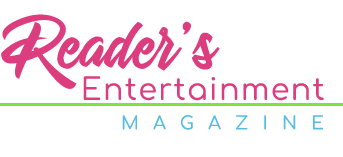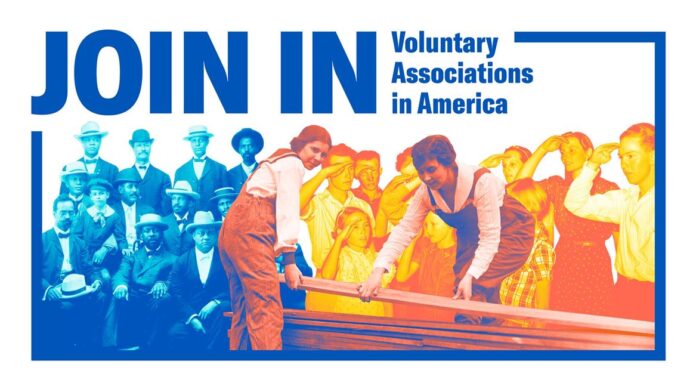The newest exhibition at the Library of Congress, “Join In: Voluntary Associations in America,” explores America’s history as a “nation of joiners” and our long tradition of volunteering for a wide range of groups and causes. The exhibition opens to the public Dec. 16 and will be on view through Dec. 31, 2023.
Americans have a longstanding impulse to join together for common purposes, such as fellowship, charity, professional growth, emergency services, societal reform and community building. “Join In: Voluntary Associations in America” opens a conversation about these organizations and their importance in society.
“Volunteering and banding together for a common purpose is baked into our DNA as Americans as we engage with many different types of organizations to confront some of our great challenges,” said Librarian of Congress Carla Hayden. “‘Join In’ is a unique new exhibition that examines this long tradition of voluntary engagement in our society.”
This history of voluntary associations reveals the aspirations of Americans as “a nation of joiners,” while also acknowledging these groups have sometimes reflected society’s exclusions, discriminations and divisions. The exhibition includes 114 artifacts, representing 45 different organizations, ranging from associations created by early American colonists to the American Red Cross, Salvation Army, NAACP, Girl Scouts, and many others that continue today.
“Voluntary associations have been an integral and defining part of American life for the entire history of this nation. Pulling together items from across Library of Congress collections, this exhibition reveals a nation of people struggling with an inheritance of conflicts and exclusions, but also motivated to join together to solve problems that face their communities,” said Nathan Dorn, curator of the exhibition. “‘Join In’ reminds us that our shared goals have drawn us again and again out of our private lives to build a world that reflects our deepest values.”
Over the next year, visitors to the exhibition can explore America’s history of engagement through voluntary groups. It’s a tradition that connects with the nation’s founding, the establishment of the American political system and groups that Americans continue to join today.
Artifacts on view will include rare books, historical manuscripts, photographs, and other materials from across the Library’s collections that document the work of associations.
10 Highlights of the Exhibition Include:
- Charters granted by the British crown to companies colonizing Virginia, Massachusetts and other early colonies gave corporations governing structures to operate in the early 1600s. This tradition would begin to provide an early toolkit for making associations.
- Passengers on the Mayflower formed a “civil body politic” with the Mayflower Compact to function as a unit until they had a warrant to form a new colony. While the original Compact is lost, “Mourt’s Relation” is an account of the colony’s early days and is the earliest surviving document containing its text.
- Congregationalist minister and author Cotton Mather would later write in his publication “Bonifacius” in the 1700s on the importance of people gathering in neighborhood associations to meet the needs of their communities.
- Benjamin Franklin became convinced associations were important for society. He first proposed a subscription library, the Library Company of Philadelphia, in 1731, and went on to form the University of Pennsylvania, the American Philosophical Society and other organizations.
- Alexis de Tocqueville’s writings on American politics and society in his book “Democracy in America” noted the relationship between Americans’ habits of forming associations and their democracy in 1840. “In democratic countries, the science of association is the mother science; the progress of all the others depends on the progress of that one,” he wrote.
- Various organizations would form to pursue shared purposes. Freemasonry formed its first lodge in the British American colonies in 1731 and would grow to count George Washington as a member during the Revolutionary War and while he served as the nation’s first president. Prince Hall Freemasonry would form to open the Masonic lodge to Black men who had been excluded previously.
- A Methodist minister’s organization to fight poverty and promote the Gospel in London would become the Salvation Army, opening its first U.S. branch in 1880. Today, it’s one of the nation’s largest charitable organizations and operates in 131 countries.
- After learning of the International Red Cross, Clara Barton would form the American National Red Cross in 1881 to organize a system for national relief to mitigate “sufferings caused by war, pestilence, famine and other calamities.” The Library holds the group’s original Articles of Incorporation and papers.
- Mary Church Terrell would join with Black women leaders to found the National Association of Colored Women in 1896. The group would advocate for women’s rights and the advancement of all African Americans as the largest federation of local Black women’s service clubs. To continue this advancement, veterans of the Niagara Movement met in 1909 to form what would become the NAACP with the goal of abolishing segregation, discrimination, disenfranchisement and racial violence. The Library holds the NAACP’s records.
- Influenced by a Scottish organization, Juliette Gordon Low would found the organization that became the Girl Scouts in 1913, emphasizing inclusiveness, service, self-reliance and the outdoors. It would become a worldwide movement for girls that now counts 2.5 million girls and adults as members.
The accompanying publication, “Join In: Voluntary Associations in America,” will be available in the Library of Congress Shop.
“Join In: Voluntary Associations in America” and related programming are made possible by funding secured by The Federalist Society, with additional funds provided by the American Bar Association, Standing Committee on the Library of Congress.
The Library of Congress is the world’s largest library, offering access to the creative record of the United States — and extensive materials from around the world — both on-site and online. It is the main research arm of the U.S. Congress and the home of the U.S. Copyright Office. Explore collections, reference services and other programs and plan a visit at loc.gov; access the official site for U.S. federal legislative information at congress.gov; and register creative works of authorship at copyright.gov.






